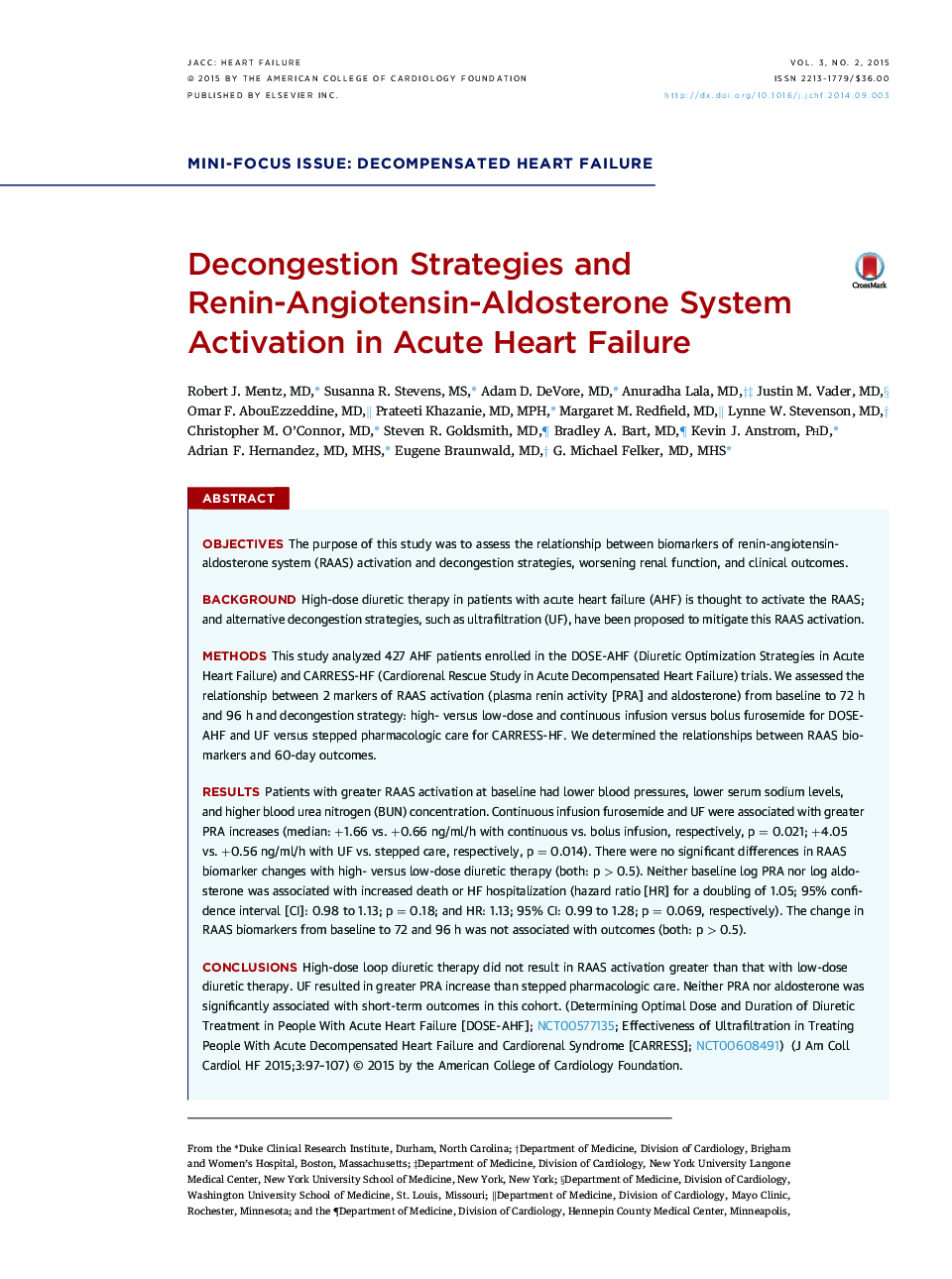| کد مقاله | کد نشریه | سال انتشار | مقاله انگلیسی | نسخه تمام متن |
|---|---|---|---|---|
| 2942479 | 1177127 | 2015 | 11 صفحه PDF | دانلود رایگان |

ObjectivesThe purpose of this study was to assess the relationship between biomarkers of renin-angiotensin-aldosterone system (RAAS) activation and decongestion strategies, worsening renal function, and clinical outcomes.BackgroundHigh-dose diuretic therapy in patients with acute heart failure (AHF) is thought to activate the RAAS; and alternative decongestion strategies, such as ultrafiltration (UF), have been proposed to mitigate this RAAS activation.MethodsThis study analyzed 427 AHF patients enrolled in the DOSE-AHF (Diuretic Optimization Strategies in Acute Heart Failure) and CARRESS-HF (Cardiorenal Rescue Study in Acute Decompensated Heart Failure) trials. We assessed the relationship between 2 markers of RAAS activation (plasma renin activity [PRA] and aldosterone) from baseline to 72 h and 96 h and decongestion strategy: high- versus low-dose and continuous infusion versus bolus furosemide for DOSE-AHF and UF versus stepped pharmacologic care for CARRESS-HF. We determined the relationships between RAAS biomarkers and 60-day outcomes.ResultsPatients with greater RAAS activation at baseline had lower blood pressures, lower serum sodium levels, and higher blood urea nitrogen (BUN) concentration. Continuous infusion furosemide and UF were associated with greater PRA increases (median: +1.66 vs. +0.66 ng/ml/h with continuous vs. bolus infusion, respectively, p = 0.021; +4.05 vs. +0.56 ng/ml/h with UF vs. stepped care, respectively, p = 0.014). There were no significant differences in RAAS biomarker changes with high- versus low-dose diuretic therapy (both: p > 0.5). Neither baseline log PRA nor log aldosterone was associated with increased death or HF hospitalization (hazard ratio [HR] for a doubling of 1.05; 95% confidence interval [CI]: 0.98 to 1.13; p = 0.18; and HR: 1.13; 95% CI: 0.99 to 1.28; p = 0.069, respectively). The change in RAAS biomarkers from baseline to 72 and 96 h was not associated with outcomes (both: p > 0.5).ConclusionsHigh-dose loop diuretic therapy did not result in RAAS activation greater than that with low-dose diuretic therapy. UF resulted in greater PRA increase than stepped pharmacologic care. Neither PRA nor aldosterone was significantly associated with short-term outcomes in this cohort. (Determining Optimal Dose and Duration of Diuretic Treatment in People With Acute Heart Failure [DOSE-AHF]; NCT00577135; Effectiveness of Ultrafiltration in Treating People With Acute Decompensated Heart Failure and Cardiorenal Syndrome [CARRESS]; NCT00608491)
Journal: JACC: Heart Failure - Volume 3, Issue 2, February 2015, Pages 97–107